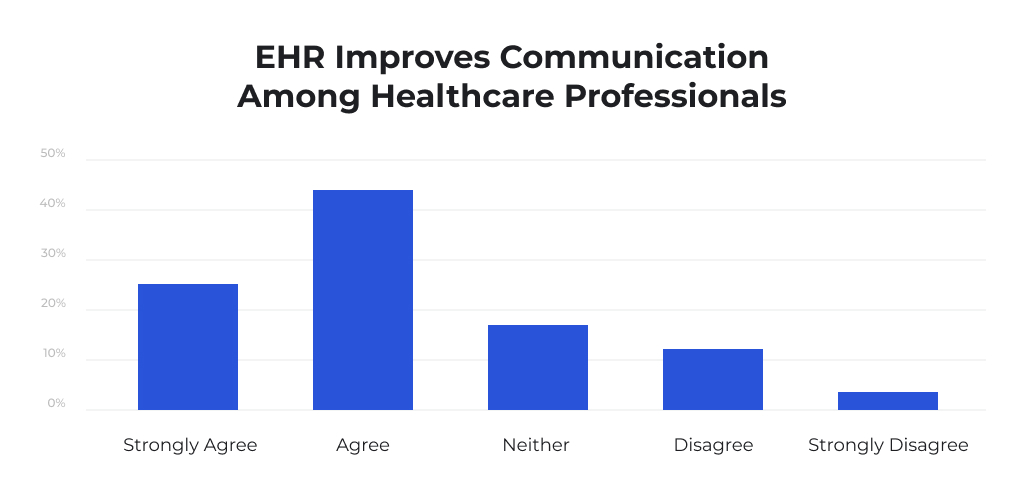EHR implementation cost breakdown is one of the most crucial aspects of the software creation process for almost any business person operating in the healthcare niche. Naturally, a business person wants to know if the software is useful and how much it costs. And while the short answer will be from USD 10k to USD 100k, there are ways to estimate the price more precisely. And that is exactly what this editorial is about.
Light IT Global has gathered all the useful information one might need to figure out the cost of EHR implementation and prepare the development budget accordingly. You’ll find out why trusting in bespoke electronic health records is a winning strategy in 2023, which factors influence the amount of money you will have to spend, and what are the most efficient ways to control costs.
Let’s talk about EHR
EHR, aka electronic health record, is a type of software that allows healthcare facilities to collect, accumulate, and maintain patients’ medical and personal information in a digital form. In a nutshell, it is an electronic alternative to traditional yet ineffective paper charts.
Due to the rapid development of the IT field, modern EHR software is able to facilitate and streamline a multitude of healthcare-related processes. It not only helps to keep the patients’ info relevant at all times, but it also simplifies the communication between medical facility’s departments, improves diagnostics, and even boosts profits.

And while EHR implementation advantages will be covered in the editorial, let’s get the basic concepts out of the way first.
There are two major approaches to EHR introduction and carrying out EHR implementation costs. The first one — trusting one of the well-known off-the-shelf solutions (e.g., Epic, Meditech, Cerner, etc.) The second one is creating a custom system.
Utilizing one of the favored electronic health records software brands is by far the most popular choice among healthcare businesses. And there’s no surprise in that, as when it comes to EHR implementation cost breakdown, ready-made solutions are cheaper and quicker to incorporate. However, the satisfaction rate is not that high for this type of digital product. Out-of-the-box systems are prone to errors and are generally more vulnerable than custom ones, they are not particularly easy to master, are full of unnecessary features, yet often lack essentials.
Custom EHR systems, on the other hand, require implementation time and are typically more costly, but the entities that choose this option win in the long run. Bespoke software is tailored to specific business needs, they are compliant and include only those features that will benefit the practitioners, the patients, and the business owner. And once we’ve touched the topic of EHR advantages, let’s take a closer look at those!
EHR Implementation Benefits from Business and Patient’s Perspective
Digitalization has changed the healthcare business completely. Once electronic patient records were introduced, there was no way back to a time-consuming and ineffective paper-based workflow. Both the entities (healthcare providers) and the clients (patients) felt the difference immediately. The most prominent perks for each involved party include the following.
Advantages for healthcare facilities
First, let’s list five of the most prominent perks both for practitioners and company owners.
Lower operational costs
Since the focus of this article is EHR implementation cost breakdown, let’s talk about costs first. By incorporating a well-executed and well-thought-out EHR, a healthcare business gets an opportunity to decrease expenditures significantly. The software’s ability to replace paper workflow, cut down documentation management/storage expenses, lower transcription costs, and improve billing accuracy are among the factors facilitating the process.
Better overall efficiency
When nearly any interaction between medical professionals can be performed in a digital format, it increases the quality and speed of said interactions. Healthcare workers can access and exchange relevant information in a matter of seconds.

Performance tracking functionality takes that even further, allowing a business owner to monitor and analyze practitioners’ workload, define possible drawbacks, and eliminate them.
Top-level security and compliance
This one applies more so to custom solutions, yet it is an advantage that shouldn’t be forgotten about, particularly when it comes to EHR implementation cost breakdown because problems with security and compliance can be one of the main reasons for major financial losses or even bankruptcy for healthcare businesses.
Offering transparency and engagement
By making a conscious effort to increase transparency and give a patient more control over their own health, medical businesses not only invest in customer loyalty but also increase brand awareness, boost customer satisfaction rate, and better the quality of care. Tools like appointment scheduling or health risk assessment instruments implemented within a user-friendly patient portal give people that feeling of control and empowerment while simultaneously transferring positive associations to your brand.
Fewer mistakes, higher quality of patient care
Back in the day, when all the tasks that are now automatically performed by an EHR were carried out exclusively by people, the number of mistakes caused by a “human factor” was skyrocketing. And we’re talking not only about malpractice and mistakes, missteps like inaccuracies in patients’ charts and billing errors happen all the time as well, leading to time waste and losses. So while the Electronic Health Record implementation cost might not be that low, it is a perfect investment for an entrepreneur. This software will minimize the number of human-caused errors and allow practitioners to give all their time to providing the best healthcare services they possibly can.
Advantages for patients
Now let’s move to the advantages the facility’s clients will most definitely experience.
More opportunities for being proactive in healthcare
When a healthcare provider has an EHR with a functional patient portal, the person is able to be more engaged and take more actions that lead to high-quality care.

The patient can not only get access to all of the medical history anytime, anywhere but also check the accuracy of the available info and inform the provider if there are any errors. Prescriptions, lab tests, and even an appointment calendar may be at the customer’s fingertips with an EHR system. Consequently, a person turns from a passive observer and care recipient into an active participant in the process.
Easy transfer between practices
While interoperability is still one of the main challenges of EHR adoption and one of the items that should be considered in the EHR implementation cost breakdown, this tool safeguards the patient’s data and makes it much easier to change a healthcare provider if needed. The days when a person visited a new hospital and all of their medical history was suddenly lost, or unavailable are now over. Even if one moves to a different city, state, and sometimes even country, their previous PCP is able to transfer the records to a new provider easily and quickly.
Better security for sensitive information
It is no secret that personal information is an asset, and many businesses are willing to pay a lot for it. That’s why data breaches are so common in the digital era, and cybersecurity is a priority for any entity that values its reputation. That’s also why one of the main aspects of an EHR implementation cost breakdown is compliance. This means that a healthcare provider that chooses to utilize an electronic health records system takes patients’ data protection very seriously, and all of their clients are much less likely to become victims of data leaks or fraud.
Factors That May Impact the Cost of EHR
While EHR implementation cost breakdown has a bunch of direct and indirect expenses that a business owner should be ready to face in any case, there also are factors that may or may not influence the final price of the solution. Let’s examine five of the most common ones.
The company’s size
One of the most reliable ways to determine the cost of EHR implementation and maintenance is to calculate it in accordance with the facility’s size and number of users. As studies show, the average annual budget per user for an EHR is around USD 1200 for practices that have not more than ten users. However, for larger facilities (11+ users), this cost is almost twice as low.

Another thing that should be taken into consideration is the required infrastructure. Smaller healthcare businesses won’t need to spend much on powerful servers, networking devices, and workstations, while for larger ones, it’s almost always a necessity.
The type of EHR
Previously we’ve mentioned that there are two types of EHR solutions based on the development process: custom and off-the-shelf. Custom software costs more, and out-of-the-box software costs less. But there are also different types of EHR systems based on the hosting. Those types are on-site (physician-hosted), SAAS (cloud-based), and remotely hosted.
Each kind of EHR system has its own pros and cons, but the most popular one is a cloud-based EHR that wins by a landslide. It not only eliminates the burden of server maintenance but also combines security and affordability. Yet, if, for whatever reason, the company chooses the on-premise option, it should be ready to face additional expenses on a regular basis.
Customization level
At first, might seem that this factor influencing EHR implementation costs is relevant only to bespoke solutions, but it isn’t true. Out-of-the-box EHR systems also offer different versions of the same software with different functionality included in the package. It allows business owners to customize EHR to some degree. Naturally, EHR implementation costs will grow if a decision-maker chooses to opt for a higher level of customization and/or developed features.
Software’s value and Time-to-market
The rule of thumb in software development is “faster time-to-market equals higher costs.” And while this principle applies mostly to custom solutions (off-the-shelf software is pretty easy and quick to integrate and use), there’s also another aspect that influences EHR price regardless of its type. This aspect is the software’s value.
The more value an EHR system can bring the business in terms of functionality, security, usability, etc., the more it typically costs. Even if the time-to-market is not fast.
IT infrastructure & capabilities
The last factor influencing the cost of EHR implementation that we’re going to cover is often overlooked by entrepreneurs, especially by startuppers. It’s the company’s existing IT infrastructure and technical capabilities.
The reason why this part of the EHR implementation cost breakdown so often is not taken into account by startups and first-time entrepreneurs is the lack of experience and/or limited budget. Companies that have already entered the market usually have their IT needs taken care of, at least to an extent. Such entities also have an idea of how much it costs to maintain and update IT infrastructure (both software and hardware). So the bottom line is if the business already has some kind of existing IT infrastructure, the price of an EHR will be lower, if not — higher.
EHR Implementation Cost Breakdown: Direct and Indirect Expenses
Now that we’ve covered all of the EHR pricing basics let’s explore the subject deeper and list out the expense items. Some of them are one-time expenditures, others are ongoing, some require a bigger budget, the others are less pricy. Still, all of them are important and worth consideration.
Direct Costs
The average time a practice takes to evaluate its options and select an EHR varies from 9 to 21 weeks. Naturally, the timeframe increases if the practice has more physicians, but still, is this time enough to make a well-thought-out decision?

For some less informed business owners, even nine weeks may seem like a very long time as, at first glance, there’s not much to investigate and evaluate. But such a mind frame is a misconception as there are plenty of items included in an EHR implementation cost breakdown, even if we’re talking about direct expenses.
Direct costs include the most obvious development and integration expenditures, and most entrepreneurs are pretty skilled at calculating the average price for their practice. Direct expenses include:
- Software cost (development, licensing, hosting, etc.)
- Hardware (computers, servers, networking equipment, printers, scanners, etc.)
- Maintenance and assistance costs
- Implementation and customization expenses (data migration, consulting, specific functionality incorporation, etc.)
- Training fees (pre-implementation and ongoing)
The amount of money one will have to spend on each of the items on this list will depend on the factors we’ve covered earlier. For example, the software cost will be formed by its type (custom or out-of-the-box), the chosen vendor, the type of hosting (cloud or physician-hosted), and even the number of practitioners (as it’s not uncommon for cloud-based EHR providers to charge a bigger fee if the number of users is growing).
The same principle can be applied to all of the elements of an EHR implementation cost breakdown. The larger and more complex the system is expected to be, the more money should be in the budget. The more people will be working using the solution, the more expensive and long training will be.
Indirect costs
While direct costs are pretty straightforward, and an entrepreneur can determine which EHR will be the most suitable and how much money will be needed to introduce it to the workflow, indirect costs remain somewhat hidden. Often even experienced business owners tend to forget or underestimate these expenses.
The most common indirect expenses that should always be included in an EHR implementation cost breakdown:
- Productivity decrease related to training and adaptation
- Revenue drop due to lower productivity
- Educational costs
- Compliance-related expenditures
- IT costs
The first months after the EHR introduction are the hardest ones for any healthcare facility. Not many business owners are truly ready to face the decrease in overall effectiveness. For some, it might even be a shock as instead of bringing benefits from day one, a newly adopted system becomes a reason for struggles for the staff. But at this stage, it is essential to remember that the additional EHR implementation costs are worth every penny, and all the difficulties are temporary.
The more responsible C-level is in terms of staff education and training, the faster an adaptation period will pass. Depending on the company’s specifics and size, it might be reasonable to hire third-party consultants and IT specialists that will take care of the system and take off the load from an in-house IT team if there’s one.

But it’s not just new software usage training a business owner should remember, compliance training is also a part of Electronic Health Record implementation cost. The dev team will take care of the technical part of the industry standards compliance, but it’s C-level’s responsibility to train the team.
Last but not least, there’s a major difference between direct and indirect costs is predictability. Direct expenses are easier to forecast and calculate, while indirect ones are changeable and not that stable. Often it is hard to predict how quickly the staff will pick up new practices and incorporate them into the workflow. So the best thing a decision-maker can do is to compose a best-case and worst-case scenario and calculate the costs accordingly.
The best ways to control EHR costs
EHR implementation cost breakdown is a great tool that helps to plan out the budget, but there are also ways to control the expenses without compromising the software’s quality. The most effective ones will be listed below.
Careful vendor evaluation and selection
No matter which type of EHR system a business owner chooses, the vendor screening process is mandatory. Different software costs differently, sometimes even if the functionality is similar. Especially important this step is for those who opt for custom solutions. Hundreds of thousands of IT vendors around the world offer electronic health record development, and the prices for EHR software development vary drastically. If the EHR implementation costs a business owner counts on aren’t unlimited, it’s more than practical to spend some time and choose a vendor that offers both great quality and competitive pricing.
Smart planning and budgeting
Another aspect of planning that can cut the cost of EHR implementation is the assessment of the company’s current state. The entrepreneur should think about all the factors that might increase the price and try to eliminate them. One of the greatest examples is IT infrastructure assessment. Is the existing software and hardware powerful and scalable enough? Are there any missing links or updates that need to be taken care of? It is always better to be prepared and avoid unexpected surprises when it comes to expenditures.
Negotiations
Even once the software vendor is chosen, the company’s representatives still have an opportunity to negotiate the best terms and EHR implementation costs. If the IT provider is reliable, it will be open to discussion. And we’re talking not only about the direct price. Time and resources that will be required for the solution’s implementation typically can also be tailored to meet the customer’s needs.

Government funding and incentives
This method of cutting EHR implementation costs will differ depending on the company’s location. If an entrepreneur wants to try it, one should conduct research if the government offers any programs and what are the ways to participate in those. Typically an organization should meet certain criteria to be considered eligible. For example, one of the requirements for Promoting Interoperability Program is meaningful use. For other government-funded initiatives in other countries, the requirements may be different.
Obviously, all the tips listed above aren’t the only ones available to entrepreneurs operating in the healthcare industry. The are many others that didn’t make it to the list. But it doesn’t mean they do not deserve mention in your company’s EHR implementation cost breakdown. Carefully evaluate all of the available opportunities, and you might find out some unique ways to control expenses that work for your business.
Final Words
The process of reducing the cost of EHR implementation isn’t particularly an easy one, as sometimes the fine line between essential expenses and things that can be sacrificed is hard to see. This is where the EHR implementation cost breakdown comes in handy. If done correctly and not in a rush, it really helps to eliminate unnecessary expense items and focus on the software development and integration aspects that bring maximum business value.
And even if after all the steps you’re still hesitant about adopting electronic health records because there are some hardships to the process, think about all the benefits you will get, about a significant improvement of the business processes, and the high-quality care your team will be able to provide to those who need it.
So if you ever need assistance with any task related to EHR development or integration, contact the Light IT Global team, we’re always ready to help and provide you with a custom, modern, and fail-safe solution that will be effective, compliant, user-friendly, and, most importantly, profitable software.




